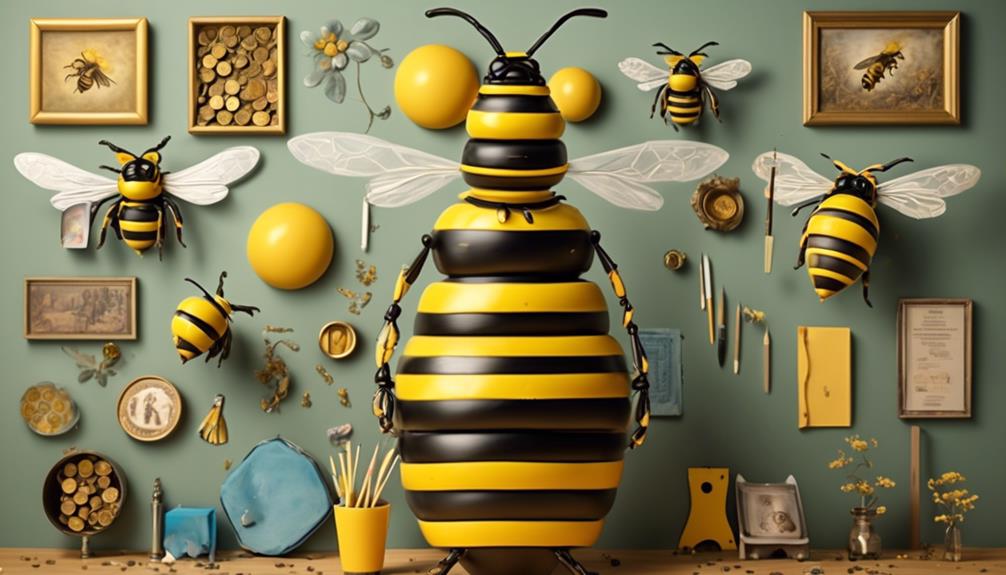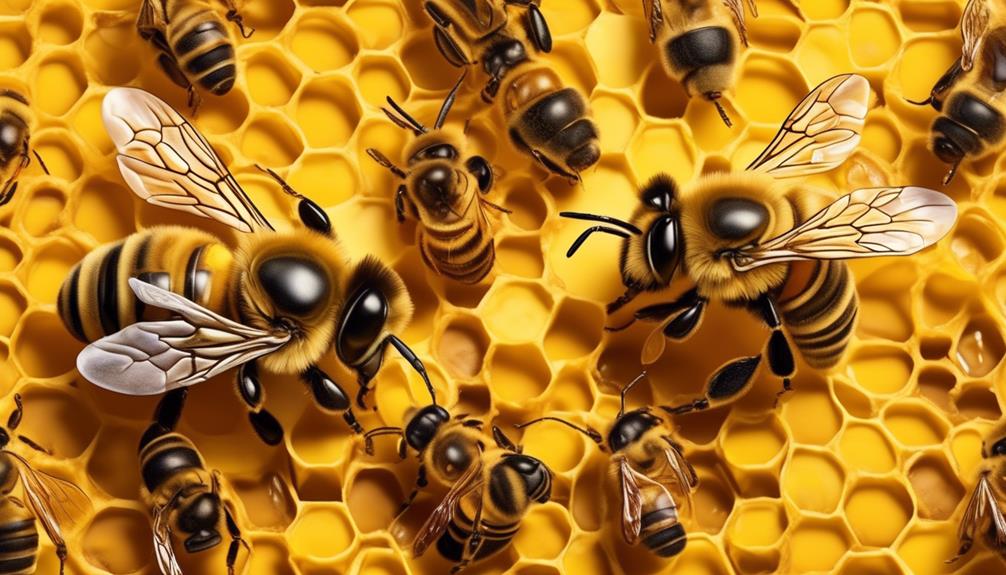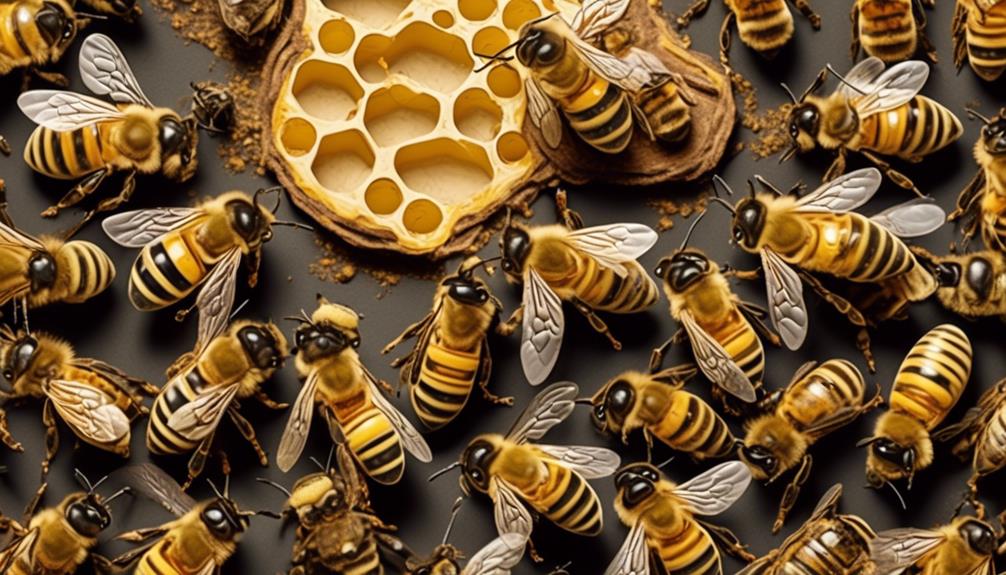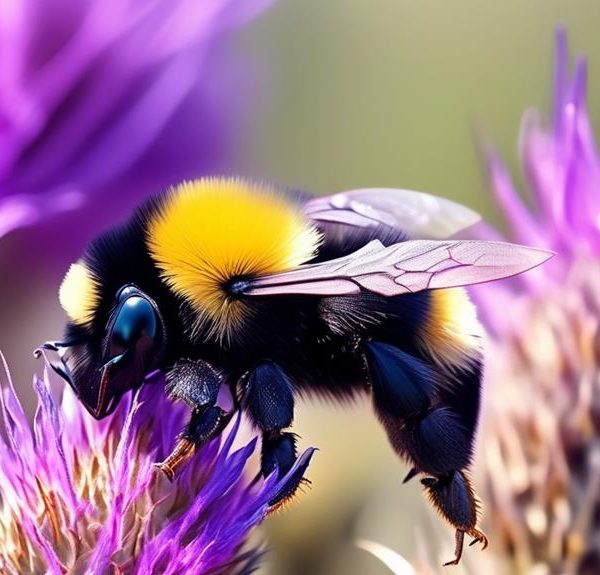Learn about the surprising size of queen bees and the key factors influencing their stature in the hive.

How Big Are Queen Bees?
Bumbling about in the buzzing world of bees, you've likely wondered just how big the queen bee actually is. You're familiar with the commonly held notion that she's larger than her loyal subjects, but have you ever considered the specifics?
Here's a hint: the size of these regal insects can be quite surprising. We're about to explore the intriguing factors that contribute to the queen bee's size and the implications it has on her role within the hive.
So, are you ready to plunge into this fascinating facet of apian anatomy?
Key Takeaways
- The queen bee is larger than worker bees, measuring up to 20mm in length.
- Genetics and diet, particularly royal jelly, influence the size of queen bees.
- Queen bees have a unique anatomy, including a longer abdomen for reproduction and a gland for producing pheromones.
- The queen bee's size is essential for her role in reproduction, pheromonal control, and maintaining social structure in the hive.
Understanding Bee Colony Hierarchy

To truly comprehend the complex world of bees, you must delve into the intricacies of their colony hierarchy. Within the buzzing society, three distinct classes reign: the queen, drones, and workers.
The queen, the most significant figure, is the only sexually mature female in the hive. Her primary role? Reproduction. She's the mother of all bees in the colony, laying up to 2000 eggs a day. It's her unique pheromones that maintain order and stability, suppressing the workers' ability to mate and signaling the colony's status.
Drones, the male bees, have one purpose: to mate with a virgin queen. They're larger than workers but smaller than the queen. Post-mating, they die, having fulfilled their purpose.
Workers, the smallest yet most numerous, are infertile females. They undertake multiple roles – from nursing larvae, constructing and repairing the hive, to foraging for food and defending the colony.
Understanding the hierarchy is crucial – it's not just about size or numbers. Each class possesses specific roles, characteristics, and behaviors that ensure the hive's survival. Imbalances or shifts can lead to colony collapse, demonstrating the delicate, interdependent nature of bee society.
Anatomy of a Queen Bee

Now that you've grasped the basics of bee colony hierarchy, let's zero in on the anatomy of the queen bee, the hive's keystone. Unlike worker bees, the queen is larger, spanning up to 20mm in length, and boasts a more streamlined, elongated body. Her wings, though, are shorter, not reaching the tip of her abdomen.
Her head houses a pair of compound eyes, antennae with superior olfactory capabilities, and a proboscis for feeding. Between her eyes, you'll find three simple eyes or 'ocelli' that detect light intensity. Her thorax, similar to other bees, carries the wings and six legs. However, the queen's hind legs lack the corbicula or 'pollen basket' found in workers.
Now, her abdomen is where things get interesting. It's longer and filled with reproductive organs, notably a spermatheca for storing sperm post-mating. She also has a stinger, but it's smoother, less barbed, and primarily used for dispatching rival queens. Lastly, she possesses a unique gland producing a pheromone cocktail that asserts her dominance, regulates hive activities, and ensures her unique status within the colony.
Factors Influencing Queen Bee Size

Diving into the factors that influence the size of a queen bee, you'll find that genetics, diet, and environmental conditions play critical roles.
The genetic makeup of a queen bee is the foundational determinant of her size. Certain subspecies of Apis mellifera, the Western honey bee, produce larger queens than others due to genetic variations.
However, genetics isn't the sole factor. Nutrition also influences the size of a queen bee. Larvae destined to become queens are fed a diet consisting almost entirely of royal jelly, a protein-rich substance produced by worker bees. This diet boosts their growth, enabling them to mature into larger bees than their worker counterparts.
Lastly, environmental conditions significantly impact queen bee size. In colder climates, larger queen bees are often favored because they can store more fat and survive the winter months. On the contrary, in warmer climates, smaller queens are more common, presumably because they require less energy to maintain body temperature.
Comparing Queen Bees With Worker Bees

In contrast to the queen bee, worker bees' size, diet, and roles within the hive present a fascinating study in the complex social structure of honey bee colonies.
Workers are generally smaller, averaging about 12-15mm in length. They're primarily fed a diet of pollen and honey, unlike queens who consume royal jelly exclusively. This difference in nutrition contributes to their disparate sizes and functions.
As you delve into their roles, you'll find worker bees are aptly named. They're responsible for an array of tasks including foraging, nursing, cleaning, and defending the hive. You'll notice a stark contrast to the queen's sole duty of reproduction.
In their lifetime, workers will change jobs according to age. Younger bees typically perform duties inside the hive like feeding larvae and tending to the queen, while older bees venture out to gather nectar and pollen. This division of labor is a crucial aspect of hive efficiency and survival.
Interestingly, the queen and worker bees come from the same type of egg. It's the quality and quantity of nutrition that determines their eventual roles. Simply put, it's a marvelous example of nature's adaptability and complexity.
Impact of Size on Queen Bee's Role

With her larger size, the queen bee embodies a significant role in the hive that's as crucial as it's unique. Her size isn't just for show; it's a physical adaptation that facilitates her primary function – reproduction.
Unlike worker bees, who are smaller and built for the tasks they perform, such as foraging for food and protecting the hive, the queen bee's larger body allows her to store a vast amount of sperm and produce thousands of eggs daily. This reproductive capability wouldn't be possible without her considerable size. Her larger abdomen is specifically designed to host an enlarged ovariole, where egg production takes place.
In addition, her size makes her more visible to the rest of the hive. This visibility enhances her ability to exert pheromonal control over the worker bees, ensuring the hive's social structure and harmony. Therefore, her size not only enables her to fulfill her reproductive duties but also supports her role as the hive's leader.
Frequently Asked Questions
How Long Does a Queen Bee Typically Live?
You're asking about the lifespan of a queen bee. Typically, a queen bee can live for three to five years, which is significantly longer than the worker bees who only live for a few weeks. However, this is dependent on a variety of factors including the quality of care she receives, her diet, and environmental conditions.
Over her lifetime, she'll produce millions of eggs, ensuring the survival and growth of her colony.
What Is the Process for a New Queen Bee to Take Over?
When a queen bee dies or becomes unproductive, a new queen takes over through a fascinating process.
Worker bees choose a few young larvae and feed them royal jelly, a substance that promotes queen development.
These larvae grow in queen cells and the first to emerge becomes the new queen, often killing any rivals.
You're witnessing nature's way of ensuring survival and continuity of the hive.
What Are Some Common Threats to Queen Bees?
Queen bees face several threats. Pesticides can be lethal or cause reproductive issues. Disease, such as Nosema, can weaken and kill them. The Varroa mite is a serious parasite. Predators like wasps and birds pose a danger, as do cold weather conditions. Interference from beekeepers can also be harmful.
Additionally, if the hive becomes too crowded, the workers may replace the queen, a process known as supersedure.
How Many Eggs Does a Queen Bee Typically Lay in a Day?
You're curious about the queen bee's egg-laying capacity, aren't you?
Well, a healthy queen bee can lay up to 1,500 to 2,000 eggs per day during peak spring and summer months.
The number can vary depending on the health of the queen and the needs of the colony, but it's fascinating that she can lay nearly her own body weight in eggs every day, isn't it?
Can There Be More Than One Queen Bee in a Colony?
Usually, you'll find only one queen bee in a colony. However, under certain circumstances, a second queen may be present. This typically happens during a period known as 'supersedure,' where an old or failing queen is replaced.
The new queen, once matured, will kill the old queen. It's a brief but crucial overlap ensuring the colony's survival. It's rare, but sometimes both queens coexist peacefully, resulting in a two-queen colony.
Conclusion
So, you've learned that the size of queen bees can vary based on numerous factors, right? They're generally larger than worker bees, a feature crucial to their role in the hive.
Their size also impacts their prolific egg-laying ability. Remember, within the intricate bee hierarchy, every aspect, including size, plays a key part.
It's a fascinating world, isn't it? The next time you see a bee, you'll appreciate the complexity behind these tiny powerhouses.


